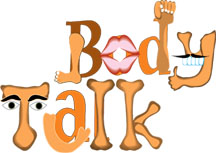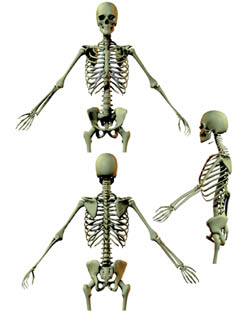
Moving on with bones
Have you ever thought what would happen if we didn't have bones?
Well, we will be floppy like a beanbag, won't we? Could you walk? Forget
it. Could you stand up? No way. Without bones, you'd be just a puddle of
skin and guts on the floor.

Remember, last week we discussed that bones have two purposes. Some,
like your backbone, provide the structure which enables you to stand
erect, instead of lying like a puddle on the floor.
Other bones protect the delicate, and sometimes soft, insides of your
body. Your skull, a series of fused bones, acts like a hard protective
helmet for your brain. The bones, or vertebrae, of your spinal column
surround your spinal cord, a complex bundle of nerves. Imagine what
could happen to your heart and lungs without the protective armour of
your rib cage!
How many bones do humans have?
When you were born, you had over 300 bones. As you grew, some of
these bones began to fuse together. The result? An adult has only 206
bones!
How do bones move?
With a lot of help. You need muscles to pull on bones so that you can
move. Along with muscles and joints, bones are responsible for you being
able to move. Your muscles are attached to bones. When muscles contract
(become smaller or shorter), the bones to which they are attached act as
levers and cause various body parts to move.
You also need joints which provide flexible connections between these
bones. Your body has different kinds of joints. Some, such as those in
your knees, work like door hinges, enabling you to move back and forth.
Those in your neck enable bones to pivot so you can turn your head.
Still other joints like the shoulder enable you to move your arms 360
degrees like a shower head.
Are bones alive?
Absolutely. Bones are made of a mix of hard stuff that gives them
strength and tons of living cells which help them grow and repair
themselves. Like other cells in your body, the bone cells rely on blood
to keep them alive. Blood brings them food and oxygen and takes away
waste.
If bones weren't made of living cells, things like broken toes or
arms would never mend. But don't worry, they do.
That's because your bone cells are busy growing and multiplying to
repair the break! How? When you break your toe, blood clots form to
close up the space between the broken segments. Then your body mobilises
bone cells to deposit more of the hard stuff to bridge the break.
Where is the largest joint in the body?
The knee joint is the largest and most complex joint in the body. The
knee is the joint where the thighbone meets the large bone of the lower
leg. The knee ligaments are the strongest connections between the femur
and the tibia. Ligaments keep the bones from moving out of position.
What's bone marrow?
Many bones are hollow. Their hollowness makes bones strong and light.
It's in the centre of many bones that bone marrow makes new red and
white blood cells.
Red blood cells ensure that oxygen is distributed to all parts of
your body and white blood cells ensure you are able to fight germs and
disease. Who would have thought that bones make blood!
Where are the vertebrae?
The vertebrae form a column of bones in the spine. The spine is the
part of the skeleton that extends down the middle of the back. The spine
plays an important role in posture and movement, and it also protects
the spinal cord.
Did you know that the human spine consists of 33 vertebrae? But some
of them grow together in adults. There are seven cervical (neck), 12
thoracic (chest region), five lumbar (lower back), five sacral (hip
region) and four coccygeal (tailbone region) vertebrae.
Most vertebrae have fibrous intervertebral discs between them to
absorb shock and enable the spine to bend.
Where is the humerus bone?
The humerus bone is in the arm. The elbow is the joint that connects
a person's upper arm with the forearm. The humerus or the bone of the
upper arm and the radius and ulna (the bone of the forearm) meet at the
elbow. The three bone connections form three smaller joints within the
elbow.
These smaller joints permit certain movements. The humerus-ulna joint
and the humerus-radius joint allow a person to bend the forearm up and
down. The radius-ulna joint and the humerus-radius joint permit a person
to rotate the forearm and to turn the palm of the hand up and down.
A capsule (pouch) of tough connective tissue surrounds the elbow
joint. This capsule and several ligaments hold the bones in place.
Bone facts
* The human hand has 27 bones; your face has 14!
* The longest bone in your body is your thigh bone, the femur - it's
about 1/4 of your height. The smallest is the stirrup bone in the ear,
which can measure 1/10 of an inch.
* Did you know that humans and giraffes have the same number of bones
in their necks? Giraffe neck vertebrae are just much, much longer!
* You have over 230 moveable and semi-moveable joints in your body.
* The patella (or knee cap) is a small, flat, triangular bone in
front of the joint. It is not directly connected with any other bone.
Muscle attachments hold it in place. |


